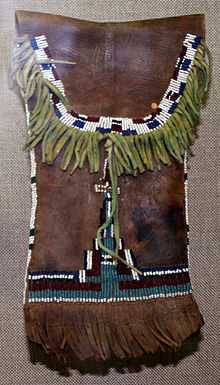Bead weaving
Bead weaving using seed beads can be done either on a loom or using one of a number of off-loom stitches.
On-loom beadweaving

When weaving on a loom, the beads are locked in between the warp threads by the weft threads. The most common bead weaving technique requires two passes of the weft thread. First, an entire row of beads is strung on the weft thread. Then the beads are pressed in between the warp threads. The needle is passed back through the beads above the warp threads to lock the beads into place. Heddle looms were popular near the beginning of the 20th century. They allowed weaving of beads by raising every other thread and inserting strung beads in the shed, the space between the lowered and raised threads. There are still a few Heddle Bead Looms being manufactured today. The most difficult part of loomwork is finishing off the warp threads.
Although loomed pieces are typically rectangular, it is possible to increase and decrease to produce angular or curvy shapes. Fringe can also be added during weaving or before the piece is removed from the loom.
Bead looms vary in size and are typically made of wood or metal. Usually, a comb or spring is used to hold the warp threads a bead-width apart. Some looms have roller bars that allow the weaver to produce pieces that are longer than the loom. Most looms are meant to sit on a table, but some have floor stands or are meant to sit in the lap.
Off-loom beadweaving
Off-loom beadweaving is a family of beadwork techniques in which seed beads are woven together into a flat fabric or a three-dimensional object such as a ball, clasp, box, or a piece of jewelry. All off-loom techniques can be accomplished using a single needle and thread (no warp threads), but some have two-needle variations. Different stitches produce pieces with distinct textures, shapes, and patterns. There are a number of different off-loom bead stitches, including:
- peyote stitch, also known as gourd stitch
- brick stitch, also known as Comanche or Cheyenne stitch
- square stitch
- herringbone stitch, also known as Ndebele stitch
- Pondo stitch, also known as African circle stitch
- right-angle weave
- triangle weave
- bead netting
- African helix
- Dutch spiral
References
- Don Pierce, Beading on a Loom. Interweave Press, 1999. ISBN 1-883010-63-2
- Carol Wilcox Wells, Creative Bead Weaving. Lark Books, 1996. ISBN 1-887374-05-1
| ||||||||||||||||||||
